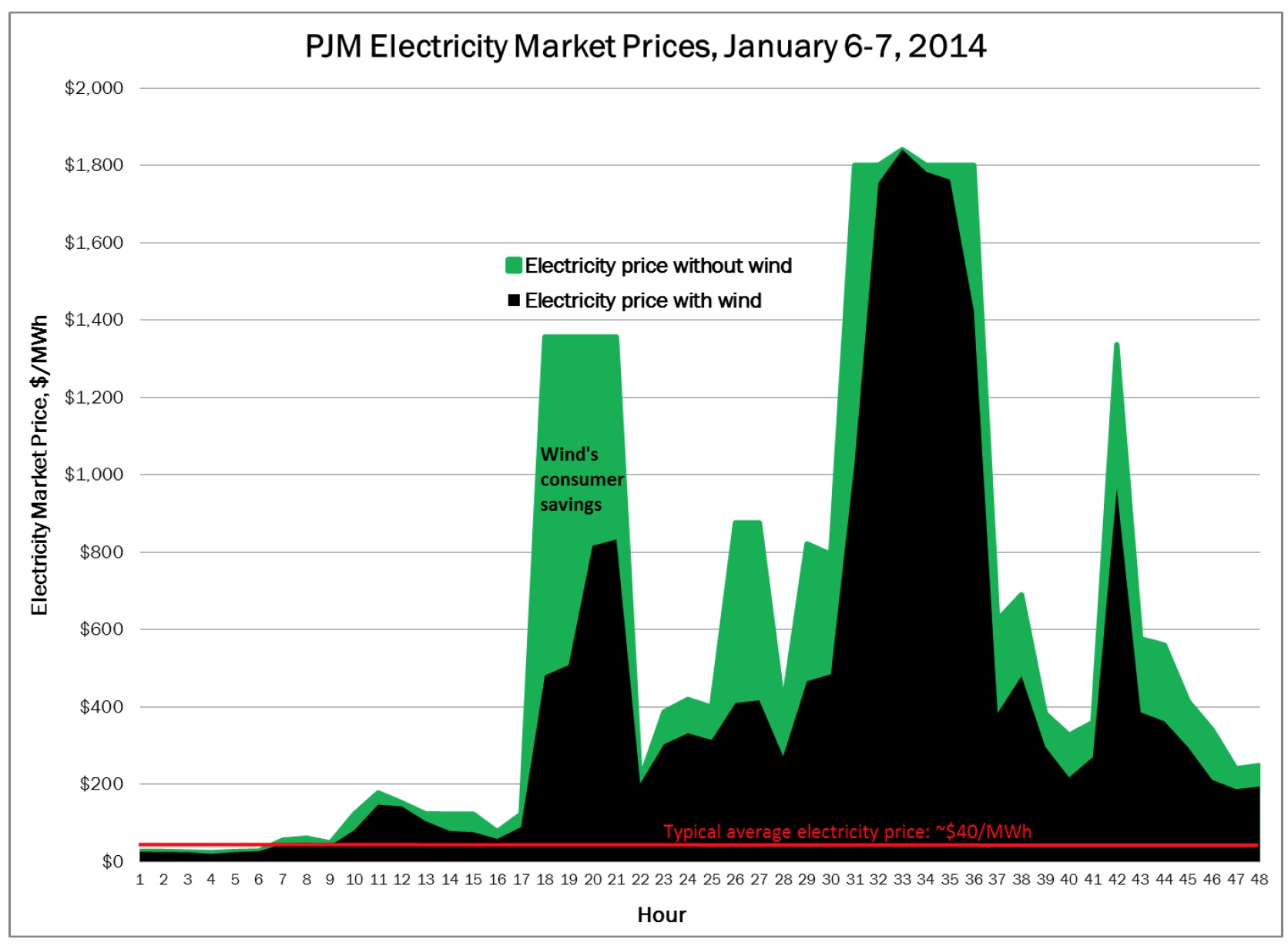AMERICAN WIND ENERGY ASSOCIATION
Introduction
Wind energy saved electricity users in the Mid-Atlantic and Great Lakes states at least $1 billion during the polar vortex event in early January 2014.
By diversifying America’s energy mix, wind energy improves electric reliability and protects consumers from energy price spikes. While wind energy always provides these benefits, they can become particularly pronounced when the electric grid is stressed.
On January 6th and 7th, 2014, frigid Arctic air blanketed the Eastern U.S. when the “polar vortex” that normally holds cold air near the North Pole briefly weakened. The extreme cold snap, which became known as the “polar vortex” event, caused unusually high demand for electricity as well as for natural gas for both heating and electricity generation. In addition, extremely low temperatures contributed to unexpected failures at many power plants, due to equipment breaking and shortages of fuel.
Driven by high demand and low supply, electricity and natural gas prices rose to dozens of times their normal levels in many regions. The Mid-Atlantic and Great Lakes states were particularly hard hit by these abnormally cold temperatures and the resulting energy prices spikes.
There and in other regions, wind energy provided large quantities of critical electricity supply when it was needed most, keeping the lights on and reducing the impact of these price spikes. Our analysis quantified the savings wind energy provided to Mid-Atlantic and Great Lakes consumers on January 6th and 7th, 2014, by calculating how much more electricity prices would have increased had the region’s wind generation not been online. Using hourly grid operator data, fuel price information, and a detailed representation of the characteristics of every power plant in the region, our analysis quantified how wind energy kept electricity price spikes in check.
Wind energy’s consumer benefits stem from wind energy’s fuel price stability. Wind is one of the few energy sources that offers perfect fuel price stability that can be locked in up front, as wind’s fuel cost will always be zero. For all other major conventional sources of electricity, fuel prices cannot be locked in for the long term and are often set by the spot market. The costs of these fuel price increases and risk are passed directly on to consumers through their electric bills. In contrast, wind energy is more like a fixed-rate mortgage, locking in the fuel price for the life of the power plant.
As shown in the table below, wind energy creates these large consumer benefits by displacing the most expensive, least efficient, and most volatilely-priced power plants with a fixed-priced, zero-fuel-cost, zero-emission energy source. All of these benefits are purely market driven, occurring entirely because zero-fuel-cost wind energy is used to displace more expensive forms of energy.
Results
Wind energy protected Mid-Atlantic and Great Lakes consumers from extreme price spikes during the polar vortex event in early January 2014, saving consumers over $1 billion on their electric bills. The black area in the following chart shows the actual power prices experienced in the electricity market that spreads across 13 Mid-Atlantic and Great Lakes states, known as PJM. As indicated by the red line at the bottom, these prices greatly exceeded typical PJM power prices. However, the green area shows that power prices would have spiked much higher had PJM not had abundant supplies of wind energy throughout this critical time period.
The shaded green area in the chart above shows the amount by which wind energy reduced the electricity price spikes. These reduced electricity prices accrue to all of the electricity that was purchased by consumers in the market, not just the wind energy that was purchased.
Download full version (PDF): Wind Energy Saves Consumers Money During the Polar Vortex
American Wind Energy Association
www.awea.org
AWEA is a national trade association representing wind power project developers, equipment suppliers, services providers, parts manufacturers, utilities, researchers, and others involved in the wind industry – one of the world’s fastest growing energy industries. In addition, AWEA represents hundreds of wind energy advocates from around the world.
Tags: American Wind Energy Association, AWEA, Polar Vortex, Wind Energy








 RSS Feed
RSS Feed